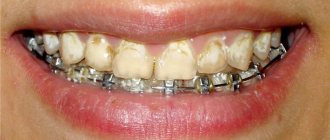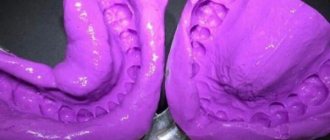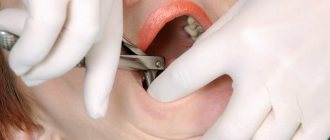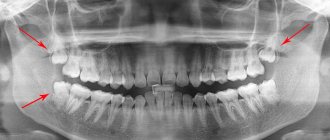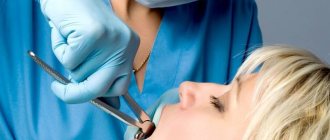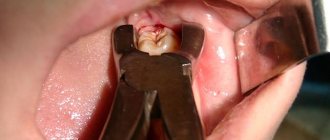Problem: see orthodontist O.A. A young girl came to Baranova complaining that her teeth were growing crookedly.
Solution: treatment with tooth extraction was performed, which is the most effective in this case. Damon metal braces were used for treatment.
Braces and wisdom teeth removal
On the Internet you can find a lot of information that before orthodontic treatment it is imperative to eliminate the eighth teeth. However, this statement is not entirely correct: “eights” are not always disposed of, but only in cases of extreme necessity. As a preventative measure, removing third molars is incorrect and even dangerous. Correctly erupted “eights” are the same part of the dentofacial apparatus as other teeth, provided, of course, that they have antagonists. Moreover, extracting the “eight” is not such an easy process.
Interesting fact!
In cases where there is clearly not enough space in the bone for the correct placement of teeth, specialists can remove the “eights” without waiting for them to erupt.
Nevertheless, when a patient is indicated for removal, experts pay attention to the wisdom teeth first - and here's why.
- They erupt later than others, between 16 and 27 years, which often negates the results of treatment carried out in adolescence.
- The process of their eruption is often associated with various complications (in about 75% of cases) - and this also affects the location of other teeth.
- “Wise” teeth sometimes remain impacted and do not participate in the bite, which makes them an unnecessary vestigial organ and a prime candidate for removal. However, there are situations when the patient simply does not have third molars or their extraction is not enough to correct the anomaly - in this case, it is necessary to resort to the removal of other teeth.
When should they be removed?
There is no universal answer: in all cases the decision is made individually. Each option has its own arguments for and against, but in general the approach is as follows:
- It is undesirable to remove healthy teeth without compelling evidence.
- Preserving wisdom teeth may carry risks for the remaining teeth and for the course of treatment. Then the benefits of removal outweigh the possible negative consequences.
Should I delete the eights?
The decision is always made individually. Sometimes it happens that one orthodontist prescribes the removal of teeth (not necessarily eights, fangs are also recommended to be removed quite often), and another cancels this decision. There is nothing unusual in this, because each specialist has his own approach and his own vision of treatment planning. Therefore, anyone who doubts the correctness of treatment tactics is recommended to undergo additional consultation with another specialist or consider treatment with a different orthodontic system. This is normal practice as systems improve and more cases of irregularities are corrected without removing teeth.
Other articles:
10 problems of those with malocclusion
All types of orthodontic systems: from plates to aligners
Removing "fours" or "sixes"
Sometimes, before installing braces, the patient needs to have the “fours” removed, that is, the first premolars - they have the smallest roots, so they are the easiest to pull out.
In addition, they bear less chewing load than, for example, molars, so their loss will not affect the patient’s health. The third candidate for removal is the fifth teeth. They are slightly larger than the “fours”, but the gaps left after their removal are practically unnoticeable when talking and smiling. Frontal teeth and canines undergo extraction much less frequently. “Sixes” are removed as a last resort, since they are quite difficult to remove, and the holes left behind them take a long time to heal. As for the seventh tooth, it is pulled out only if there is a healthy eighth tooth, in order to shift part of the load onto it. In addition, which teeth need to be extracted depends on the type of bite.
✔
In case of crossbites and distal bites, premolars, that is, either the fourth or fifth teeth, are most often removed.
✔
In case of an open bite associated with severe crowding and/or protrusion - protrusion of one of the jaws, removal of the upper and lower premolars, and at a very young age, also the canines, is indicated.
✔
As for the mesial bite, to correct it, the lower incisors are eliminated - in case of underdevelopment of the upper jaw - or “eights”.
Important!
A competent specialist, regardless of the indications, will always prefer to remove a diseased or decayed tooth rather than a healthy one.
Is it worth installing one system?
Installing braces on the upper jaw at an affordable price in Moscow is an advantageous offer that allows you to save money on bite treatment. But experts do not advise making the decision to correct only one jaw on your own. This method of eliminating bite defects is permissible only if the orthodontist confirms the absence of serious violations in the upper row and the need for correction of the lower jaw.
If the patient, despite the advice of a specialist, wants to install only one corrective system, then the doctor warns about the possible consequences. Most patients have problems closing their jaws after removing braces. Thus, even greater deformation occurs, requiring repeated, but complex treatment with a dual system.
Tooth extraction before installing braces and treatment time
In most cases, contrary to popular belief, extraction does not increase the treatment time, but, on the contrary, shortens it. For example, if the patient has severe crowding, then extraction will speed up the process of moving teeth by at least a couple of months, if not more. However, if the situation allows you to do without removal, then the fate of the tooth depends on the patient’s decision. In addition, you should not be afraid that after extraction there will be gaps between the teeth - they will close during orthodontic treatment. Usually it takes from three months to six months to eliminate them, depending on which tooth was removed. The gaps close at a rate of approximately 1 mm per month, so the smaller the tooth removed, the faster they will heal. As mentioned earlier, the smallest holes remain after removing the “fours”. Extraction is usually performed a week before braces are installed.
Important!
Removing an inflamed tooth during orthodontic treatment can negatively affect the timing of correction, therefore, before installing braces, the oral cavity must be completely sanitized.
Bite correction with braces
Metal bracket system – made of stainless alloy.
An excellent option for those who do not want to spend money on expensive types of less noticeable braces. Moreover, their functionality, despite their cheapness, is no different from any others. Sapphire brace system is a device where braces are made of sapphires
These braces are very aesthetic, ideal for those who do not want to spoil their appearance. They are easy to maintain by the dentist. Sapphire braces can even be considered jewelry! Just think, you have precious stones in your mouth. People around you will immediately appreciate how precious your own teeth are to you, since you care so much about them.
Is it possible to avoid tooth extraction?
In order not to be faced with the choice of which tooth to remove and whether it is worth doing it, it is necessary to monitor the formation of the child’s bite from an early age. Many parents believe that they need to make an appointment with an orthodontist only when baby teeth are replaced by permanent teeth. This is an erroneous opinion: it is recommended to show the child to a specialist for the first time at the age of 2-3 years, so that the doctor can identify the prerequisites for the development of dental anomalies in time.
What do parents of young children need to pay attention to?
- On the child’s bad habits (constantly sucking his thumb, chewing on various objects, and will not part with his pacifier). Even improper bottle feeding can lead to underdeveloped jaws.
- Due to adenoids or frequent acute respiratory viral infections, the child adapts to improper (oral) breathing, and this negatively affects the condition of the entire dental system.
- Children sleep incorrectly (throw their heads back too far, put their fists under their cheeks, etc.). They don't watch their posture. All this prevents the correct formation of the dentition and the temporomandibular joint.
If these problems are addressed in a timely manner, then in the future there may be no need to remove healthy teeth that interfere with orthodontic correction. The orthodontist will prescribe myogymnastics and select vestibular plates and trainers. Treatment in adulthood, if carried out, will be more comfortable and take less time.
Question answer
Is it always possible to use braces to move teeth to the place where they were removed?
If one tooth is missing, you can do without implantation. But usually this is only possible if there is a shortage of chewing units (provided there is sufficient bone tissue). They differ little in function and form. If there are missing front teeth, implantation will be required. Frontal units vary in size and shape; their displacement will cause an aesthetic defect in the smile area.
Levin Dmitry Valerievich
Maxillofacial surgeon, chief physician of the Center
Does it make sense to wear braces without removing teeth?
As we have found out, removal is required in cases where there is not enough space in the jaw for the correct arrangement of teeth. Unfortunately, without extraction in such situations, orthodontic treatment will be ineffective. The teeth, taking the desired position, will either be forced to shift their inclination, or simply will not budge. Only timely orthodontic treatment in childhood will help to avoid removal.
Publisher: Expert magazine about dentistry Startsmile.ru
Author of the material: Yaroslav Ikonnikov
Features of complex operations
Removing eights becomes more difficult if:
- location on the lower jaw. The lower teeth have a more massive and developed root system, and higher jaw bone density;
- tooth growth at an angle to the dentition or in a horizontal direction;
- incomplete eruption;
- tortuosity, entanglement of roots, especially when there are many of them;
- proximity of neighboring units, making it difficult to remove the figure eight;
Complex removals can be performed not only under local anesthesia, but also with sedation. Painkillers are administered together with sedatives and are selected individually. Operations under sedation provide psychological comfort and painlessness.
Rehabilitation
During the recovery period, dentists prescribe a course of antibacterial therapy and painkillers for the shortest possible course. That is, you should take analgesics as long as the pain persists. Most often, non-steroidal anti-inflammatory drugs based on ibuprofen and nimesulide (Nise) are prescribed for pain, which effectively relieve both pain and inflammation.
Antihistamines are prescribed to prevent generalized swelling in the area of the tooth socket.
It is highly advisable to quit smoking: nicotine interferes with the normal blood clotting process and can cause bleeding.
To speed up wound healing, it is recommended to rinse your mouth with antiseptics and eat liquid and soft foods for several days.
Contraindications
There are local and general diseases that are contraindications to extirpation of the unit. In this case, the tooth is removed after therapy and preparation of the patient; in case of severe concomitant pathologies in the anamnesis, it is better to carry it out in a hospital setting:
- odontogenic periodontitis;
- diseases of the hematopoietic system;
- stomatitis, gingivitis;
- lesions of the mucous membrane due to viruses, syphilis, tuberculosis;
- hypertensive crisis;
- pregnancy;
- blood diseases;
- nervous system;
- psychical deviations;
- chronic heart disease;
- precancerous conditions, benign/malignant tumors.


